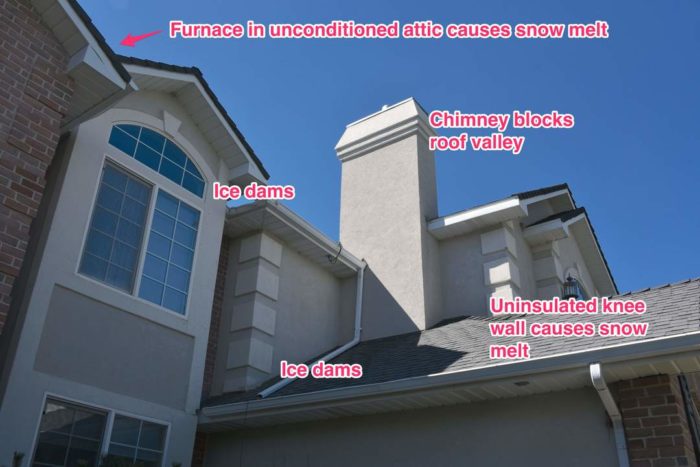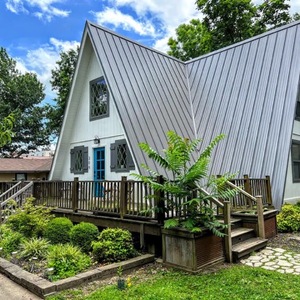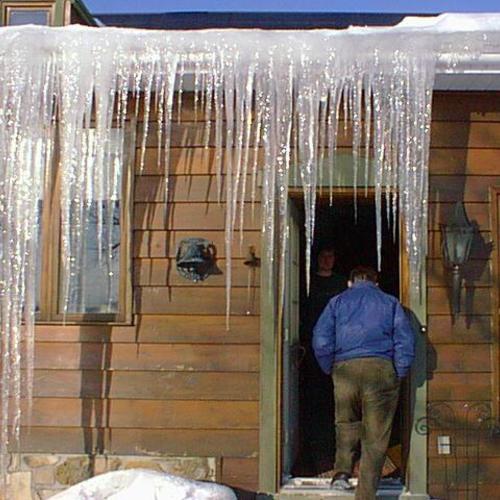
Image Credit: Chris Butson
Chris Butson’s Utah home sits at an elevation of 6,000 feet and experiences everything from sub-zero temperatures in the winter to 100-degree summer days. Built in 1994, the house has what Butson believes is an underinsulated roof that contributes to big electric bills and massive ice dams.
“From what I have observed, the roof/attic was not insulated well when built,” Butson writes in a post on GBA’s Q&A column. “This has been partly remedied by blowing in extra insulation into the attic, but most of the cathedral ceilings were framed with 2x12s with probably 8-inch or 9-inch thick batts of fiberglass. In short, the roof has lots of heat gain during the summer and lots of heat loss in winter.”
To compensate, the builder installed a huge air conditioning unit to make summers more comfortable, as well as hundreds of feet of heating cables along the eaves to melt ice dams as they form in winter. Does it work? No. “Not surprisingly,” Butson says, “our electric bill is quite high and we have massive ice dams.”
Butson has done his homework. His solution includes adding rigid foam insulation of some kind on top of the existing roof sheathing to get the R-value up to 49, adding blown-in insulation to the attic, improving attic ventilation, eliminating skylights, and building a conditioned mechanical room in the attic for the furnace and AC equipment.
“Does this plan sound reasonable, or am I missing something fundamental?” he asks. “Why do I never see heating cable in cold regions in Europe? In fact, I have several German friends and colleagues and they don’t even know what I’m talking about. Is my perception correct and if so what is different about the way their houses are built?”
That’s the…
Weekly Newsletter
Get building science and energy efficiency advice, plus special offers, in your inbox.

This article is only available to GBA Prime Members
Sign up for a free trial and get instant access to this article as well as GBA’s complete library of premium articles and construction details.
Start Free TrialAlready a member? Log in















6 Comments
Hot, not cold, right?
Doesn't Peter mean to say "there are plenty of well-performing, durable "HOT" or unvented cathedral roof assemblies?" He wrote "cold." It's always been my understanding that an unvented roof assembly was a "hot" roof...
Response to John Birch
John,
You're right, of course. Thanks for catching the error. I have corrected it.
The phrase "cold roof" refers to a vented roof assembly. The phrase "hot roof" refers to an unvented roof assembly.
attic ventilation, cfm of soffit / ridge vent
There are many references at GBA on the number of inches of NFVA are needed but how does this equate to CFM ? Is the amount of CFM dependant on the roof's slope? Air temperature both inside and out?
Thanks
Response to Walt Ott
Walt,
Building codes have mandated that vented unconditioned attics be equipped with ventilation openings that meet certain requirements. The standard code formula requires 1 square foot of net free ventilation area (NFVA) for every 300 square feet of attic floor area, assuming that half of the ventilation openings are located in the lower half of the attic (generally at the soffit) and half near or at the ridge. If a roof has only soffit vents and no ridge vents, most codes require 1 square foot of net free ventilation area (NFVA) for every 150 square feet of attic floor area.
These code requirements are not based on science. Research shows that the most important factor in preventing moisture problems in attics is to create an airtight ceiling, not to provide ventilation.
There is no direct correlation between NFVA and CFM of air movement. Research shows that ventilation through soffit vents and ridge vents is almost entirely dependent on wind speed.
For more information on these issues, see All About Attic Venting.
attic ventilation, cfm of soffit / ridge vent
Well I guess I should ask the base question. We had ice dams.
this summer I've sealed and Insulated as much as possible. I may need ventilation( we'll find out this year) there is no soffit, there is almost NO room above the top plate or for several feet inward from there.
So here my crazy idea: I can vent at the top of the roof and allow air to escape and I can also pull in cold air from the outside and duct it to the bottom of each bay. Would this work ? How much air CFM do I need?
Thanks again
Walt
Response to Walt Ott
Walt,
For advice on ice dams, I suggest that you read these two GBA articles:
Prevent Ice Dams With Air Sealing and Insulation
Ice Dam Basics
If you have only a limited area between the top plates of your exterior walls and the underside of your roof sheathing, it's hard to get enough insulation as well as a vent channel in this critical location. In that case, by far the best solution is to install an adequately thick layer of rigid foam above the existing roof sheathing. For more information on this work, see How to Install Rigid Foam On Top of Roof Sheathing.
Adding ventilation channels without addressing air leaks and insulation issues is rarely successful. If you end up installing thick rigid foam above your rigid insulation, however, you can install ventilation channels above the rigid foam if you want, followed by a second layer of roof sheathing and new roofing. The work isn't cheap, but it's a robust solution to ice damming problems.
Log in or become a member to post a comment.
Sign up Log in